Forming a green shipping corridor is a process that involves multiple stakeholders. Provided below are documents, reports, and other resources that can help you navigate this process, and more quickly develop and deploy green shipping corridors.
| Title | Description | Author | Date | Tags | |
|---|---|---|---|---|---|
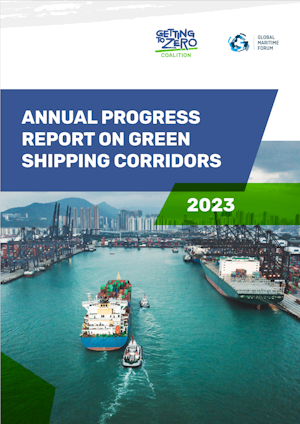 | 2023 Annual Progress Report on Green Shipping Corridors | This report, prepared by the Getting to Zero Coalition, reveals a world embracing the potential of green shipping corridors. From decisive fuel choices to setting operational targets, corridors are becoming catalysts for pre-investment activities. | Global Maritime Forum | December 2023 | 2023, GMF, Progress Report |
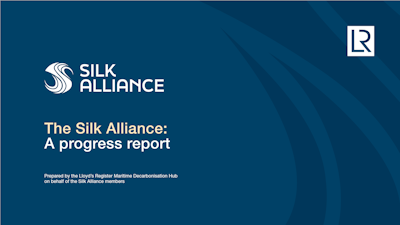 | Silk Alliance Progress Report | This report builds on the outcomes of the Silk Alliance’s full-member workshop, held in Singapore in October 2023, and summarises the progress and next steps for the initiative. The report highlights completed activities and key, immediate next steps for the initiative, falling under the following three workstreams: fleet and fuel demand; fuel supply; and finance. | Lloyd’s Register Maritime Decarbonisation Hub | November 2023 | 2023, Silk Alliance, Lloyd’s Register, Progress Report |
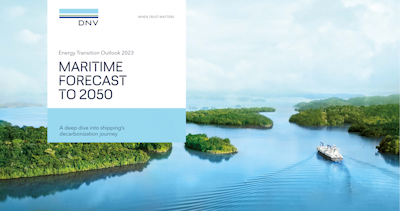 | DNV Maritime Forecast to 2050 | DNV’s 2023 edition of its Maritime Forecast to 2050 includes a section on green shipping corridors (p.57) explaining what is meant by green shipping corridors and the role they play in decarbonising the global shipping fleet. The section provides an overview of announced initiatives as well as DNV’s stepwise approach to assist stakeholders in their initiation and development of green shipping corridors. | DNV Maritime Authority | October 2023 | 2023, DNV, Forecast |
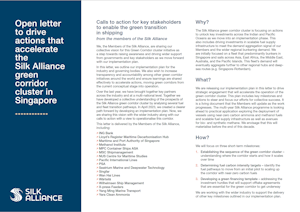 | Silk Alliance Open Letter | This open letter outlines the Silk Alliance members’ collective vision for the green corridor initiative with the purpose of raising awareness and driving wider support from governments and key stakeholders as the initiative moves forward with their implementation plan. The implementation plan is included in the letter, with key milestones and actions to reach collective success, and will be updated by members as the work progresses. | Lloyd’s Register Maritime Decarbonisation Hub | October 2023 | 2023, Silk Alliance, Lloyd’s Register |
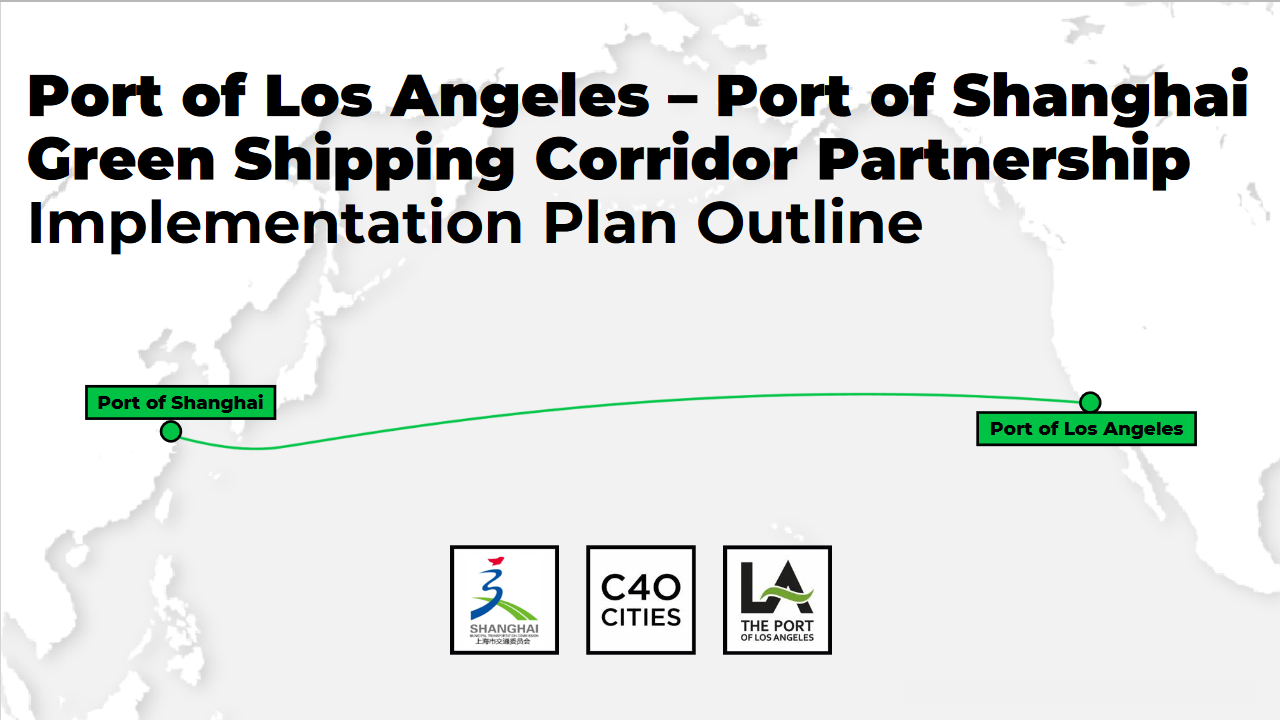 | Port of LA-Port of Shanghai Green Shipping Corridor Implementation Plan Outline | This implementation plan highlights the worldwide need for action on shipping decarbonisation; the why behind creating a green shipping corridor; and the scope of the Port of LA-Shanghai green shipping corridor initiative. The corridor’s goals are unveiled along with the ongoing partnership activities to deliver on these goals. | C40, Port of LA, Port of Shanghai | September 2023 | 2023, United States, Framework |
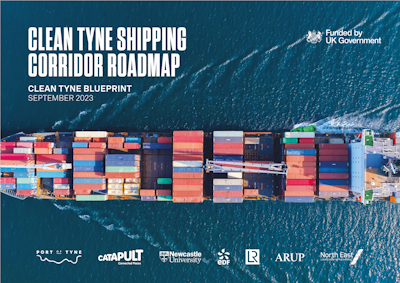 | Clean Tyne Shipping Corridor Roadmap | This Roadmap has been created as a blueprint for establishing a green methanol-powered green shipping corridor along the Tyne-Rotterdam route. A series of milestones and activities have been identified to be delivered by Port of Tyne, its customers, and the green methanol supply chain, to enable the supply of a green methanol bunkering hub at the Port of Tyne and the overall development of the Clean Tyne Shipping Corridor. | Port of Tyne, Connected Places Catapult, LR, Arup, Newcastle University, North East LEP | September 2023 | 2023, United Kingdom, Netherlands, Framework |
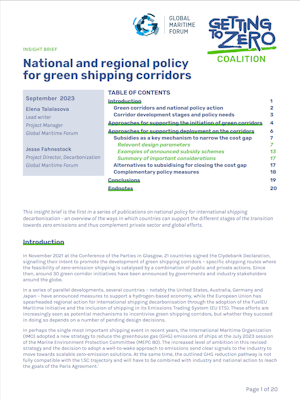 | National and regional policy for green shipping corridors | This first-of-its-kind insight brief outlines the importance of national and regional policy in delivering green shipping corridors and explores ways in which countries can support their initiation and deployment. It outlines how the overarching goal of green shipping corridors can support broader national objectives and which policy approaches that are suitable for different stages in a green shipping corridor’s development. Importantly, the insight brief explores subsidies as a key mechanism to narrowing the cost gap, including the rationale for different subsidies, and compares the potential advantages of different policy combinations. | Global Maritime Forum | September 2023 | 2023, Global Maritime Forum, Analysis |
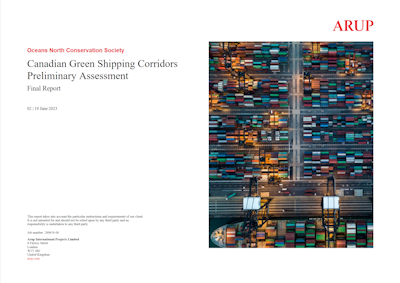 | Canadian Green Shipping Corridors Preliminary Assessment | This report is a preliminary assessment of the impact green shipping corridors – and maritime decarbonisation more broadly – can have in Canada and investigates the potential development of low and zero emission fuel uptake from shipping using three Canadian ports. The report applies characteristics of emerging initiatives to a Canadian context and explores key considerations that influence their suitability to different regions. It also looks at how green corridors can be used to mobilise key stakeholders in the fuel production value chain to stimulate uptake and estimates fuel demand evolution in the three ports based on different scenarios. Importantly, a ‘Total Value’ framework is applied to explore key financial, social, and economic co-benefits that green shipping corridors could help realise. | ARUP | June 2023 | 2023, Canada, Feasibility |
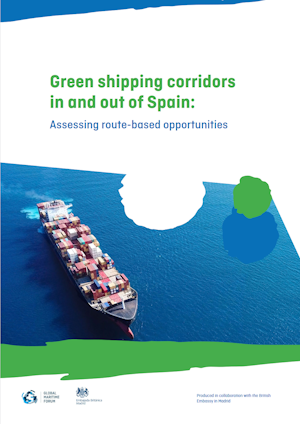 | Green Shipping Corridors in and out of Spain | Building on the “Green Corridors: The Spanish Opportunity” paper, showing that green shipping corridors represent a significant opportunity for the Spanish economy, this report assesses the route-based opportunities that exists for establishing green corridors to and from Spain across several shipping segments, countries, and ports. The methodology for identifying and assessing the routes, as well as engaging key stakeholders in the process, is outlined, followed by a prioritisation of promising green corridor candidates based on impact and feasibility. The report concludes on a final list of priority corridors to undergo further assessment with recommendations for next steps. | Global Maritime Forum | June 2023 | 2023, Spain, GMF, Building Blocks |
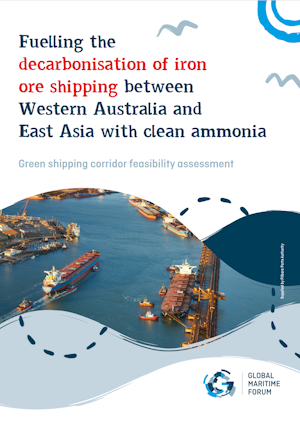 | Australia-East Asia Iron Ore Green Corridor Feasibility Study | As a follow-up from “The Next Wave” report, identifying the iron ore shipping routes between Western Australia and East Asia as strong first-mover green shipping corridors candidates, this study assesses the feasibility of implementing the Australia-East Asia Iron Ore Green Corridor with clean ammonia as a fuel. The study assesses the feasibility of a scenario where clean ammonia-powered vessels are first deployed in 2028 and then ramped up following an S-shaped curve to full decarbonisation in 2050. The report focuses on the following three questions, to which conclusions and recommendations for next steps are provided: • Vessels: Can ammonia-powered vessels be put on the water when needed? • Fuel: Could enough clean ammonia be available to power these vessels? • Bunkering: Could ammonia bunkering be available in Singapore and/or the Pilbara region of Western Australia? | Global Maritime Forum | June 2023 | 2023, Feasibility, Pacific |
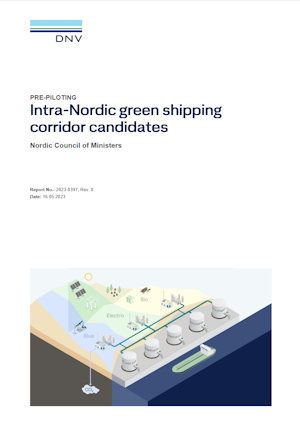 | Nordic Roadmap: Intra-Nordic Green Shipping Corridor Candidates | This report contains the delivered outcomes of the Nordic Roadmap’s pre-piloting project which was led by DNV on behalf of the Nordic Council of Ministers. The objective of the project was to identify intra-Nordic shipping routes which have the potential of realising a green shipping corridor by 2035, or towards 2030, as a follow-up to the Clydebank declaration launch at COP26. The report explains the three-step approach that was taken to identify the potential first mover intra-Nordic shipping routes and concludes on key barriers stakeholders must overcome to realise green shipping corridors as well as recommendations for next steps. | DNV Maritime Authority | May 2023 | 2023, DNV, Norway, Framework |
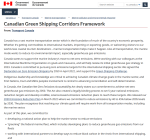 | Canadian Green Shipping Corridors Framework | Canada has developed a national green shipping corridors framework to guide organizations that are developing green shipping corridors and ensure consistent implementation. The Framework outlines how the Government of Transport Canada will support stakeholder efforts, including by aligning action at different levels, supporting clean fuels and technologies to reduce maritime emissions, and implementing other corridor support measures. Guidance on steps to take in implementing green corridors are also provided as a starting point for parties interested in developing green shipping corridors. | Transport Canada | November 2022 | 2022, Canada, Framework |
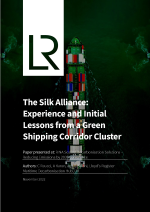 | The Silk Alliance: Experience and Initial Lessons from a Green Shipping Corridor Cluster | This paper was presented at the RINA Scaling Decarbonisation Solutions: Reducing Emissions by 2030 conference. It introduces The Silk Alliance, a green shipping corridor cluster initiative established by LR Maritime Decarbonisation Hub and relevant cross-supply chain stakeholders with the goal of developing a fleet fuel transition strategy for the establishment of a green corridor cluster in Singapore and the wider Asia region. It describes the progress made so far on the initiative, and the essons learned during its first phase. | Lloyd's Register Maritime Decarbonisation Hub | November 2022 | 2022, Lessons Learned, Singapore, Lloyd's Register, Silk Alliance |
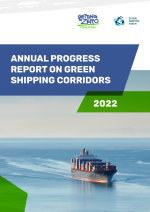 | Annual Progress Report on Green Shipping Corridors 2022 | The Annual Progress Report on Green Shipping Corridors 2022, produced by the Global Maritime Forum on behalf of the Getting to Zero Coalition, tracks how far the green shipping corridor movement has come since the launch of the Clydebank Declaration one year ago at COP26. It takes stock of the existing green corridor initiatives by looking at their geographic distribution, stakeholders involved, shipping segments and fuels of choice. It then describes the main ways the national governments are choosing to support the movement, highlighting challenges as well as emerging best practices. Finally, it provides recommendations on priority next steps to help the movement achieve its goal of accelerating the transition to zero-emission shipping. | Getting to Zero Coalition, Global Maritime Forum | November 2022 | 2022, GMF, Progress Report |
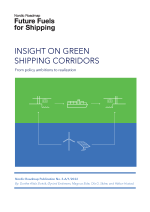 | Insight Paper on Green Corridors | Produced as part of the Nordic Roadmap project, this paper provides a short overview of the fundamentals of green corridors and how they can effectively contribute to the uptake of zero-emission fuels. It then draws on lessons learned from decarbonisation projects in the Nordic region – including operational battery-electric green corridors – to provide practical guidance on realizing new green shipping corridors. | DNV Maritime Authority, Nordic Roadmap | November 2022 | 2022, DNV, Analysis |
 | Green Corridors: Pre-Feasibility Phase Blueprint Summary Report | This summary report provides an overview of the upcoming Green Corridor Pre-Feasibility Blueprint being released in December 2022 by the Mærsk Mc-Kinney Møller Center for Zero Carbon Shipping and Rocky Mountain Institute under the Green Hydrogen Catapult. The Blueprint is envisioned as a ready-to-use guide for understanding green corridor options in a given area of focus – port, country, or region. | Mærsk Mc-Kinney Møller Center for Zero Carbon Shipping, Rocky Mountain Institute | November 2022 | 2022, Mærsk Mc-Kinney Møller Center, Feasibility, Hydrogen |
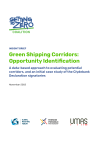 | Green Shipping Corridors: Opportunity Identification | This Insight Brief by UMAS uses data previously produced for the Getting to Zero Coalition Strategy for the Transition to Zero-Emission Shipping to examine the nature and scale of the potential for green corridors among signatories to the Clydebank Declaration. Three case study routes within Clydebank countries – a) domestic shipping around Oita/Osaka, Japan; b) the transpacific container route between Osaka, Japan, and Long Beach, USA; and c) the ferry route between Immingham, UK, and Hoek van Holland in the Netherlands – are also analysed, illustrating how a data-driven approach can support the selection and design of potential corridors. The analysis is the first step in a wider effort to make the data from the Transition Strategy available to interested companies and governments to support their consideration, prioritisation, and implementation of green corridors. | Getting to Zero Coalition: Global Maritime Forum, Mission Possible Partnership, UMAS | November 2022 | 2022, GMF, UMAS, Analysis |
| Green Corridor Opportunities by Country Pairings Dataset | This first-of-a-kind data quantifies the potential for early adoption of hydrogen-derived fuels between countries across the world, including estimates of the energy demand, number of vessels, median vessel age, and the main vessel segments on their shared shipping routes. First produced for the Getting to Zero Coalition’s Strategy for the Transition to Zero-Emission Shipping, it is being made publicly available to enable governments and industry actors to assess, at a high-level, the location and scale of their green corridor opportunity, as a starting point for further efforts. It was released alongside and is a companion to the insight brief 'Green Shipping Corridors: Opportunity Identification'. | UMAS/UCL | November 2022 | 2022, Data, Analysis, UMAS | |
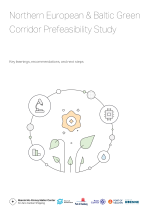 | Northern European & Baltic Green Corridor Prefeasibility Study | The European Green Corridor Network pre-feasibility study – was carried out by Mærsk Mc-Kinney Møller Center for Zero Carbon Shipping in partnership with Port of Gdynia, the Port of Roenne, the Port of Rotterdam, the Hamburg Port Authority, and the Port of Tallinn - to determine the opportunities for green shipping corridors in the greater North Sea – Skagerrak – Kattegat - Baltic Sea region. It assesses the current regional maritime activity, vessels, and voyage patterns, alternative fuel production, supply, and port readiness to cater for potential vessels operating on alternative fuels, the outlook on cost of emissions reduction and cost to end-customers, before outlining recommendations to all stakeholders to progress green corridors in the region. The study finds that ferry lines, passenger and vehicle carriers could be advantageous starting points for green corridors in the region, which would be supplemented by feeder containers to support the scale of zero-emission shipping and fuels. The outlook shows that because the region is at the forefront of establishing zero-emission fuel production facilities a range of potential zero-emission fuels could be available. The first phase of zero-emission fuels will be methanol, as this builds on the already available engines as well as the fact that passenger transport routes in this decade are likely to use methanol. | European Green Corridor Network, Mærsk Mc-Kinney Møller Center for Zero Carbon Shipping | October 2022 | 2022, Mærsk Mc-Kinney Møller Center, Feasibility |
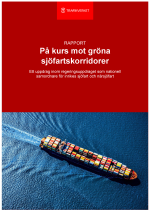 | On Course towards Green Shipping Corridors (Swedish: På kurs mot gröna sjöfartskorridorer) | This report provides an overview and synthesis of outcomes from the Swedish Transport Administration’s preliminary investigation of green corridors. It provides background information about green shipping corridors, Sweden’s work to support the development of green corridors, an overview of the status of different alternative marine fuels, perspectives from and on the role of different parts of the maritime value chain in Sweden in realising corridors, and identifies 11 Swedish routes that are judged to have good conditions for continuation dialogue and collaboration around green corridors. | Swedish Transport Administration (Swedish: Trafikverket) | October 2022 | 2022, Sweden, Analysis |
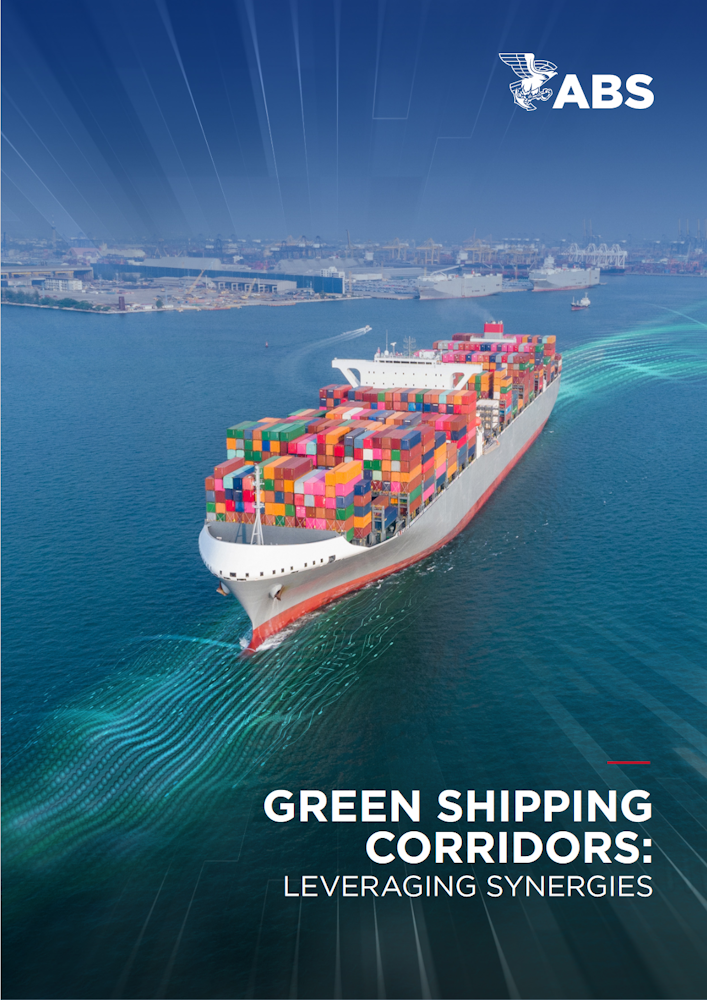 | Green Shipping Corridors: Leveraging Synergies | Over the course of the next decade and beyond, green shipping corridors are expected to act as a catalyst for the global energy transition by providing frameworks for regional and international stakeholders to collaborate on maritime decarbonization goals. Green Shipping Corridors: Leveraging Synergies, provides the foundation needed for making informed decisions regarding selecting, establishing and utilizing green shipping corridors. | American Bureau of Shipping | October 2022 | 2022, American Bureau of Shipping, Framework, United States |
 | Green Corridors: Feasibility Phase Blueprint | This blueprint, produced by the Mærsk Mc-Kinney Møller Center for Zero Carbon Shipping, in a joint effort with McKinsey & Company, provides an approach to designing and demonstrating the feasibility of green corridors. It is intended to serve as a ready-to-use guide for any stakeholder involved in green corridors for decarbonizing shipping and includes 80+ off-the-shelf pages outlining methodology, analysis, and illustrative templates at each step of the value chain and across the ecosystem. | Mærsk Mc-Kinney Møller Center for Zero Carbon Shipping, McKinsey & Company | August 2022 | 2022, Framework, Building Blocks, Feasibility, Mærsk Mc-Kinney Møller Center |
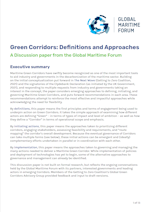 | Green Corridors: Definitions and Approaches | Building on the initial conceptualization of green corridors put forward in 'The Next Wave' (Getting to Zero Coalition, 2021), this paper considers emerging approaches to defining, initiating, and governing maritime green corridors as seen in corridor initiatives under development, and puts forward recommendations in each area, including taking a data-driven, 'technology-centric', and programmatic approach to their implementation. | Global Maritime Forum | August 2022 | 2022, GMF, Building Blocks |
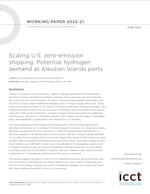 | Scaling U.S. Zero-Emission Shipping: Potential Hydrogen Demand at Aleutian Islands Ports | This study estimates the volume of fuel demand and potential market size, in U.S. dollars, for three scenarios for future LH2 refueling in Alaska. We assess all transpacific ship operations in 2019 and include latent demand for LH2from the sizeable local fishing fleets in Dutch Harbor. We find a large potential demand for LH2 ship fuel at Aleutian Islands ports that ranges from about 10,000 tonnes per year(market value estimated at $39million assuming 2035 prices) from ships alreadyvisiting Dutch Harbor up to 260,000 tonnes (more than $1 billion) if oceangoing vessels divert to Alaska to refuel as part of a mature transpacific hydrogen network. An even larger potential market (up to $1.6 billion) could be captured if Alaska makes early, proactive investments in LH2 bunkering infrastructure that lock in customers. | International Council on Clean Transportation (ICCT) | June 2022 | 2022, ICCT, United States, Analysis, Hydrogen, Case Study |
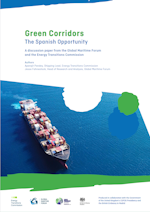 | Green Corridors: The Spanish Opportunity | This report was presented as a discussion paper for a workshop on green shipping corridors held at the British Embassy in Madrid in March 2022. Developed by the Global Maritime Forum (GMF) and the Energy Transitions Commission (ETC), it applies the approach and insights developed in 'The Next Wave' report to Spain, assessing the extent to which the country possesses critical building blocks for the successful implementation of green corridors. It argues that Spain has a unique opportunity related to the production and bunkering of zero-emission fuels for international shipping and offers initial considerations for next steps to realise this opportunity through green corridors. | Global Maritime Forum, Energy Transitions Commission, UK Embassy of Madrid | May 2022 | 2022, GMF, Building Blocks, Case Study, Analysis, Spain |
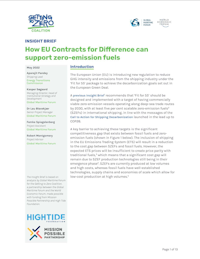 | How EU Contracts for Difference can support zero-emission fuel | This study makes a case for how the EU could use a portion of shipping related ETS revenues to fund a program of targeted Contracts for Difference (CfDs) to incentivize private investment into the production and use of scalable zero-emission shipping fuels. The potential to maximise the impact of the program by targeting it towards supporting green corridors is assessed, as well as the potential design and routing considerations for this application of the programme. | Global Maritime Forum, Energy Transitions Commission | May 2022 | 2022, GMF, European Union, Finance |
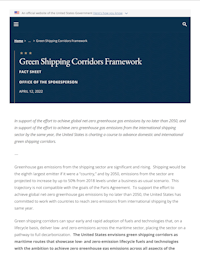 | US Green Shipping Corridors Framework | Green shipping corridors are a key means of spurring the early adoption of zero-emission fuels and technologies that will help place the sector on a pathway to align with the goal to limit global temperature rise to 1.5-degrees C. This framework sets out the U.S. vision of green shipping corridors as maritime routes that showcase low- and zero-emission lifecycle fuels and technologies with the ambition to achieve zero greenhouse gas emissions across all aspects of the corridor in support of sector-wide decarbonization no later than 2050. The framework also elaborates on the potential steps and multiple pathways through which a fully decarbonized corridor can be achieved. | US Government | April 2022 | 2022, United States, Building Blocks, Framework |
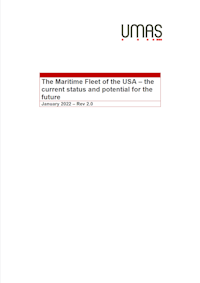 | The Maritime Fleet of the USA: The Current Status and Potential for the Future | This report, released by Ocean Conservancy, in partnership with University Maritime Advisory Services, evaluates the potential for the US to become a leader in the transition of shipping to zero emission fuels. It details the characteristics of the the US-registered fleet, provides a discussion of the Jones Act and its role in shaping the US fleet, analyses the operational behaviour and emissions of the fleet and, finally, identifies routes and locations with the highest potential for US green corridors. It finds that a number of routes have the potential for early decarbonisation, including on the Pacific coast, in the Gulf of Mexico, and Great Lakes. | UMAS, Ocean Conservancy | April 2022 | 2022, United States, Analysis, UMAS, Case Study |
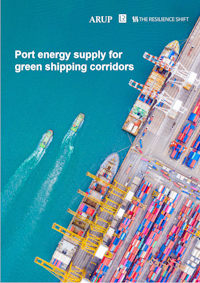 | Port Energy Supply for Green Shipping Corridors | This report from Arup, Lloyd's Register and The Resilience Shift explores the opportunities and challenges associated with developing infrastructure for alternative fuels. It focuses on a case study of a green shipping triangle in the Atlantic Ocean, assessing the infrastructure required for low carbon fuel supply in the triangle. It finds that significant scale required for initial projects and, therefore, the need for an integrated approach to their development. | Lloyd’s Register Maritime Decarbonisation Hub, ARUP, The Resilience Shift | March 2022 | 2022, Lloyd’s Register, Case Study, ARUP |
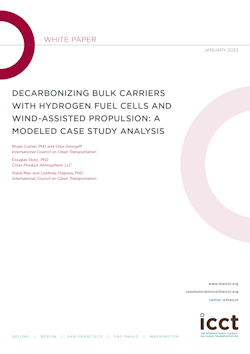 | Decarbonizing Bulk Carriers with Hydrogen Fuel Cells and Wind-Assisted Propulsion: a Modeled Case Study Analysis | This paper considers whether LH2 fuel cells or compressed hydrogen (CH2) fuel cells could replace fossil fuels for bulk carriers by investigating three ships of varying sizes: a 57,000 deadweight tonne (dwt) dry bulk carrier transiting the Chinese coast; a 69,000 dwt ore and coal carrier sailing the North American Great Lakes; and a 7,570 dwt cement carrier operating in Europe’s North and Baltic Seas. The authors used 2019 Automatic Identification System (AIS) ship traffic data and weather data observations to estimate the ships’ total energy use and the energy-saving potential of rotor sails for two routes for each ship. As shown in the figure below, the two larger ships could complete both of their modeled routes using LH2, even without the help of wind-assisted propulsion. The smallest bulk carrier does not have as much space available for LH2, and that makes it relatively more challenging for this ship. Still, results show additional legs could be achieved for the smallest ship by using rotor sails in combination with LH2, and for the two longest legs, by replacing 2.4% of its cargo space with LH2 in combination with four rotor sails. | International Council on Clean Transportation (ICCT) | January 2022 | 2022, ICCT, Hydrogen, China, Case Study |
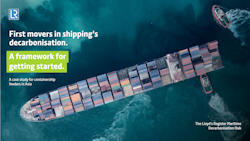 | First Movers in Shipping’s Decarbonisation | This report, produced by the Lloyd's Register Decarbonisation Hub, provides a methodology for detailed comparison of different fuel transition pathways for a shipping fleet on a given trade route. The framework is applied to a fleet of containership feeders operating between Singapore, Hong Kong, and other Asian countries nearby, to demonstrate how it can be used to support the development of green corridors. | Lloyd’s Register Maritime Decarbonisation Hub | December 2021 | 2021, Building Blocks, Framework, Lloyd’s Register |
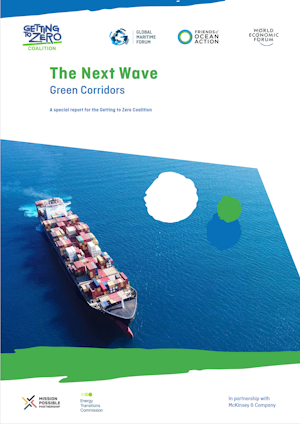 | The Next Wave: Green Corridors | Launched by the Getting to Zero Coalition and Energy Transitions Commission at COP26, this study seeks to provide an independent analysis of how green corridors can be conceived, prioritised, and designed. Three pre-feasibility studies, covering the Australia-Japan iron ore ore route, Asia-Europe container route, and Northeast Asia-US car carrier route, are undertaken to generate insights about how public and private stakeholders can succeed in developing such corridors around the world. | Global Maritime Forum, Energy Transitions Commission, McKinsey & Company | November 2021 | 2021, GMF, Building Blocks, Case Study |
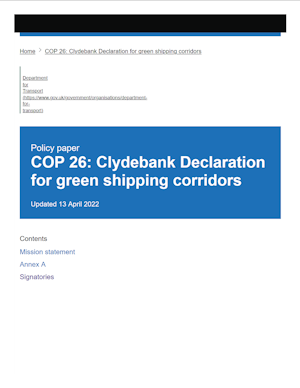 | Clydebank Declaration for Green Shipping Corridors | The Government of the United Kingdom announced the launch of the Clydebank Declaration at COP26 in Glasgow in November 2021, under which signatory states declare their ambition and intent to support the establishment of green shipping corridors. The Declaration outlines the signatories' shared goals relating to green corridors, the actions they pledge to take to support the establish of corridors, and the approaches they will seek to take to working with the value chain in realising green corridors. A continuously updated list of signatory governments is included as an annex. | UK Government | April 2021 | 2021, United Kingdom, Clydebank Declaration, COP |
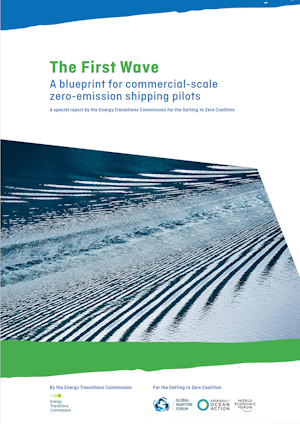 | The First Wave | Produced by the Energy Transitions Commission for the Getting to Zero Coalition, this report explains how ‘first movers’ from across the maritime value chain can come together to lower the economic, technical, and regulatory barriers faced by commercial-scale zero-emission shipping pilots. Although pre-dating the emergence of the green corridor concept, it provides a number of considerations that could be relevant to the design and pursuit of green corridor projects, including cost reduction and risk mitigation strategies for each segment of the value chain. | Global Maritime Forum, Energy Transitions Commission | November 2020 | 2020, GMF, Building Blocks |
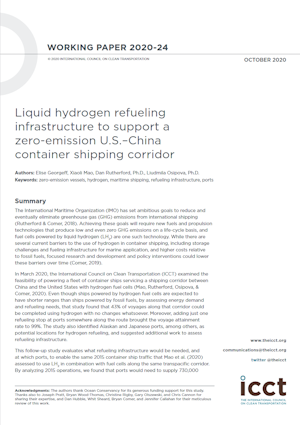 | Liquid Hydrogen Refueling Infrastructure to Support a Zero-Emission U.S.–China Container Shipping Corridor | This is a follow-up to our March 2020 study that examined the potential of using hydrogen fuel cells to power container ships servicing a busy corridor between China and the United States. According to that analysis, 99% of the voyages made in 2015 could be powered by hydrogen with only minor changes to fuel capacity or operations, by replacing 5% of cargo space with more hydrogen fuel or by adding one additional port of call to refuel. (43% of 2015 voyages could be completed with no changes at all.) This working paper focuses on refueling demand and evaluates what refueling infrastructure would be needed, and at which ports, to enable the same 2015 container ship traffic to use liquid hydrogen (LH2) in combination with fuel cells along the same transpacific corridor. | International Council on Clean Transportation (ICCT) | October 2020 | 2020, ICCT, China, United States, Hydrogen, Analysis, Case Study |
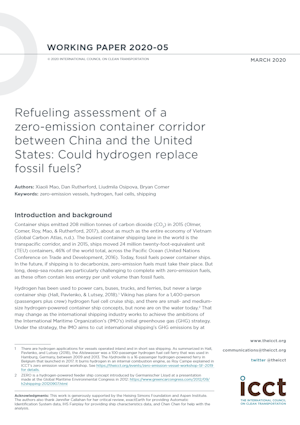 | Refueling Assessment of a Zero-Emission Container Corridor Between China and the United States: Could Hydrogen Replace Fossil Fuels? | this study models the energy demand and fuel storage space requirements of container ships servicing a corridor from China to the United States, one of the busiest shipping lanes in the world, when powered by hydrogen. The hydrogen is stored as a cryogenic liquid and used in a fuel cell that would replace heavy fuel oil in an internal combustion engine, which these ships currently use. The paper also identifies ports within the corridor where hydrogen refueling infrastructure might later be developed. | International Council on Clean Transportation (ICCT) | March 2020 | 2020, ICCT, China, United States, Hydrogen, Analysis, Case Study |
| Title | Description | Author | Date | Tags |
Additional Green Shipping Corridor Tools and Resources
The tools and resources provided below are developed and maintained by members of the Mission Innovation Zero-emission Shipping Mission. These resources are intended to help accelerate green corridor formation through partnerships, knowledge access, and better coordination.
Green shipping corridors require strong partnerships across different regions, countries, and even continents. This interactive map allows interested partners and stakeholders to more easily find one another to pursue green shipping corridor formation.
Explore the green corridor routes that have already been announced or established across the world using this interactive map. Approximate routes are displayed, showing details about timeline and target fuels and vessels.
Contact Us:
Zero Emission Shipping Mission: shippingmission@dma.dk